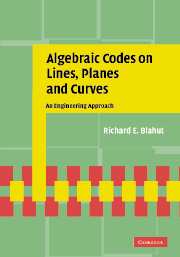Book contents
- Frontmatter
- Contents
- List of figures
- List of tables
- Preface
- Dedication
- 1 Sequences and the One-Dimensional Fourier Transform
- 2 The Fourier Transform and Cyclic Codes
- 3 The Many Decoding Algorithms for Reed–Solomon Codes
- 4 Within or Beyond the Packing Radius
- 5 Arrays and the Two-Dimensional Fourier Transform
- 6 The Fourier Transform and Bicyclic Codes
- 7 Arrays and the Algebra of Bivariate Polynomials
- 8 Computation of Minimal Bases
- 9 Curves, Surfaces, and Vector Spaces
- 10 Codes on Curves and Surfaces
- 11 Other Representations of Codes on Curves
- 12 The Many Decoding Algorithms for Codes on Curves
- Bibliography
- Index
12 - The Many Decoding Algorithms for Codes on Curves
Published online by Cambridge University Press: 05 October 2009
- Frontmatter
- Contents
- List of figures
- List of tables
- Preface
- Dedication
- 1 Sequences and the One-Dimensional Fourier Transform
- 2 The Fourier Transform and Cyclic Codes
- 3 The Many Decoding Algorithms for Reed–Solomon Codes
- 4 Within or Beyond the Packing Radius
- 5 Arrays and the Two-Dimensional Fourier Transform
- 6 The Fourier Transform and Bicyclic Codes
- 7 Arrays and the Algebra of Bivariate Polynomials
- 8 Computation of Minimal Bases
- 9 Curves, Surfaces, and Vector Spaces
- 10 Codes on Curves and Surfaces
- 11 Other Representations of Codes on Curves
- 12 The Many Decoding Algorithms for Codes on Curves
- Bibliography
- Index
Summary
Codes based on the two-dimensional Fourier transform can be decoded by methods analogous to those methods discussed in Chapter 3 for decoding codes that are based on the one-dimensional Fourier transform, such as the Reed–Solomon codes and other BCH codes. Just as for decoding one-dimensional cyclic codes, the task of finding the errors may be divided into two subtasks: finding the locations of the errors, then finding the magnitudes of the errors. In particular, the family of locator decoding algorithms introduces the notion of a bivariate error-locator polynomial, Λ(x, y), into one step of the decoding. However, we no longer have the neat equality that we had in one dimension between the degree of the locator polynomial Λ(x) and the number of its zeros. It now takes several polynomials to specify a finite number of bivariate zeros, and so, in two dimensions, we use the locator ideal instead of a locator polynomial as was used in one dimension. Now we have a neat equality between the number of zeros of the locator ideal {Λℓ(x, y) | ℓ = 1, …, L} and the area of the locator footprint.
The methods for decoding two-dimensional bicyclic codes can also be applied to the decoding of codes on curves. However, restricting a code to a curve in general increases the minimum distance. This means that the decoding algorithm must then be strengthened to reach the minimum distance of the code.
- Type
- Chapter
- Information
- Algebraic Codes on Lines, Planes, and CurvesAn Engineering Approach, pp. 484 - 524Publisher: Cambridge University PressPrint publication year: 2008



